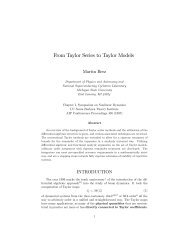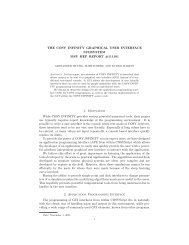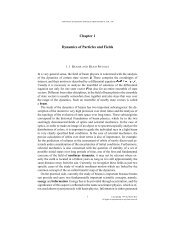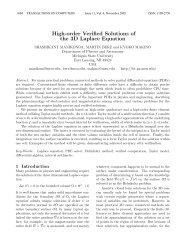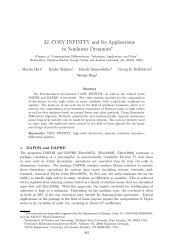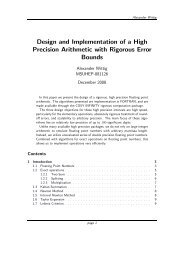Analytical Properties of Power Series on Levi-Civita Fields 1 ...
Analytical Properties of Power Series on Levi-Civita Fields 1 ...
Analytical Properties of Power Series on Levi-Civita Fields 1 ...
Create successful ePaper yourself
Turn your PDF publications into a flip-book with our unique Google optimized e-Paper software.
K. Shamseddine and M. Berz<br />
Since |(x − y 0 ) [0]| < η − |(y 0 − x 0 ) [0]|, we obtain that<br />
|(x − x 0 ) [0]| ≤ |(x − y 0 ) [0]| + |(y 0 − x 0 ) [0]| < η.<br />
Hence ∑ ∞<br />
n=0 a n (x − x 0 ) n c<strong>on</strong>verges absolutely weakly in R (resp. C).<br />
Now let q ∈ Q be given. Then<br />
( ∞<br />
) (<br />
∑<br />
∞<br />
)<br />
∑<br />
f(x)[q] = a n (x − x 0 ) n [q] = a n (y 0 − x 0 + x − y 0 ) n [q]<br />
=<br />
n=0<br />
∞∑<br />
n=0 k=0<br />
k!<br />
n=0<br />
n∑<br />
( )<br />
n . . . (n − k + 1)<br />
a n (y 0 − x 0 ) n−k (x − y 0 ) k [q] .(3.4)<br />
Because <str<strong>on</strong>g>of</str<strong>on</strong>g> absolute c<strong>on</strong>vergence in R (resp. C), we can interchange the order<br />
<str<strong>on</strong>g>of</str<strong>on</strong>g> the sums in Equati<strong>on</strong> (3.4) to obtain<br />
( ∞<br />
(<br />
∑ ∞<br />
) )<br />
1 ∑<br />
f(x)[q] =<br />
n . . . (n − k + 1) a n (y 0 − x 0 ) n−k (x − y 0 ) k [q]<br />
k!<br />
k=0 n=k<br />
( ∞<br />
)<br />
∑ f (k) (y 0 )<br />
=<br />
(x − y 0 ) k [q] .<br />
k!<br />
k=0<br />
( ∑∞<br />
Thus, for all q ∈ Q, we have that<br />
k=0 f (k) (y 0 ) /k! (x − y 0 ) k) [q] c<strong>on</strong>verges<br />
in R (resp. C) to f(x) [q].<br />
C<strong>on</strong>sider the sequence (A m ) m≥1<br />
, where A m = ∑ m<br />
k=0 f (k) (y 0 ) /k! (x − y 0 ) k<br />
for each m ≥ 1. Since (a n ) is regular and since λ (y 0 − x 0 ) ≥ 0, we obtain<br />
that the sequence ( f (k) (y 0 ) ) is regular. Since, in additi<strong>on</strong>, λ (x − y 0 ) ≥ 0,<br />
we obtain that the sequence (A m ) itself is regular. Since (A m ) is regular<br />
and since (A m [q]) c<strong>on</strong>verges in R (resp. C) to f(x)[q] for all q ∈ Q,<br />
we<br />
∑<br />
finally obtain that (A m ) c<strong>on</strong>verges weakly to f(x); and we can write<br />
∞<br />
k=0 f (k) (y 0 ) /k! (x − y 0 ) k = f (x) = ∑ ∞<br />
n=0 a n (x − x 0 ) n for all x satisfying<br />
|(x − y 0 ) [0]| < η − |(y 0 − x 0 ) [0]|.<br />
Next we show that η − |(y 0 − x 0 ) [0]| is indeed the radius <str<strong>on</strong>g>of</str<strong>on</strong>g> weak c<strong>on</strong>vergence<br />
<str<strong>on</strong>g>of</str<strong>on</strong>g> ∑ ∞<br />
k=0 f (k) (y 0 ) / (k!) (x − y 0 ) k . So let r > η−|(y 0 − x 0 ) [0]| be given in<br />
R; we will show that there exists x ∈ R (resp. C) satisfying |(x − y 0 ) [0]| < r<br />
such that the power series ∑ ∞<br />
k=0 f (k) (y 0 ) / (k!) (x − y 0 ) k is weakly divergent.<br />
If (y 0 − x 0 ) [0] = 0, let x = y 0 + (r + η)/2. Then we obtain that<br />
|(x − y 0 ) [0]| = r + η<br />
2 [0] = r + η<br />
2<br />
12<br />
< r.



